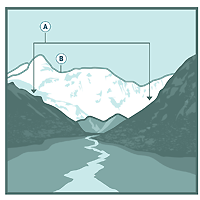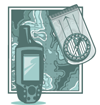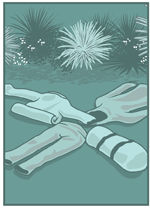The Manual: Finding Lost Hikers

'august 2010 skills the manual lost hiker 200x170'
Ways to Stay Found | So You’re Lost/Stay or Go? | Guidelines for Walking Out/Staying Put | Find a Lost Hiker
No surprise: The main task of search-and-rescue teams is finding wayward hikers. In our new book, BACKPACKER’S Outdoor Survival ($13, falconguides.com), excerpted here, author Molly Absolon advises what to do if you or a friend goes missing.
Ways to Stay Found
1. Note the landmarks you pass. Do the mountains trend north-south? Are there major features that can keep you clued in to the cardinal directions? Describe aloud the shape of the hills, and look over your shoulder to get another perspective.
2. Pick out handrails and landings. Handrails are features, such as valley walls (A) or a river, that act as a barrier, keeping you on the correct line of travel. Landings are places where things change—like a trail junction, a river crossing, or a mountain saddle (B). Once you encounter that landing, your handrails will change.
3. Look at the landscape before consulting your map. When you’re tired, it’s easy to look at your map and decide you’re close to your destination. To avoid this trap, first identify key points, like a lake inlet, a low pass, or a prominent mountain, and then locate them on the map. Only then try to home in on your location.
4. Keep track of time. Note when you leave camp and what time you pass major terrain features, so you have a sense of your pace and what time you should expect to arrive at your destination.
5. Stay together while hiking. You don’t have to hike lockstep with your companions, but you should have a system for staying in contact. That may mean having a designated leader out front and someone else bringing up the rear; keeping everyone in view when crossing open areas; or agreeing to rendezvous at decision points, like trail junctions or river crossings.
6. Know your campsite. Memorize its surroundings, especially if it’s in the trees.
7. Practice map, compass, and GPS often. It’s easy for navigational skills to get rusty.


Ways to Stay Found | So You’re Lost/Stay or Go? | Guidelines for Walking Out/Staying Put | Find a Lost Hiker
So You’re Lost
Most people who spend a lot of time in the wilderness have been disoriented or flat-out lost at some point. So, what do you do? First, don’t panic. Stop, take a deep breath, and evaluate your situation. As the legendary mountaineer and founder of the National Outdoor Leadership School, Paul Petzoldt, used to say, “Stop and smoke a cigarette.” That is, settle down and come up with a plan. Here’s how:
1. Retrace your steps in your mind. Can you backtrack? Do you know where you came from and how to return there?
2. Find a high point from which to observe your location. Look for major rivers, signs of humans, or familiar landforms.
3. Scout the area for recognizable features. If you can’t reach a viewpoint, find something else that will orient you. But search in pairs, explore for set amounts of time, and make sure you can retrace your steps back to your group or gear.
Do You Stay or Do You Go?
You’ve probably heard the old adage: Don’t move when you get lost. Often, this is the best advice, but not always. You should attempt to walk out only if one or more of these variables is true:
> The area you are in is unsafe.
> Bad weather is approaching, and you have no shelter.
> Nobody knows you’re missing and won’t notice for days, so a search won’t be launched anytime soon.
> You’re in a place where you or a signal–like a smoky fire or flashing mirror –won’t be noticed. In this case, decide whether it’s best to move to a noticeable spot or walk out.
Ways to Stay Found | So You’re Lost/Stay or Go? | Guidelines for Walking Out/Staying Put | Find a Lost Hiker
Guidelines for Walking Out
If your best bet is to walk to safety, these two basic ground rules can maximize your chances of success:
1. Attempt to hike to a road. Roads lead to towns, farms, houses, people. Start by following rivers downstream—stick to the bigger drainages. Sooner or later, a road will likely cross these streams. In general, trails heading away from mountains will likewise take you to roads.
2. Leave notes in obvious places. Let searchers know of your intentions by placing notes, arrows made of rocks, a bright bandanna, or some other sign at trail junctions, on the edge of meadows, or by other noticeable landmarks.
Guidelines for Staying Put
If you know that people are going to come looking soon, your best bet is to find an obvious place and remain there until you are found. Get comfortable: Pick a spot protected from the elements, improvise a shelter, build a fire, and stay hydrated. The other main goal is to make yourself noticeable:
>> Flash mirrors or shiny objects. Aircraft tend to notice these signals the most easily. First, look through the sighting hole and aim the mirror toward the sun until a fireball appears on the mirror’s reflective mesh. Adjust the mirror until the plane appears in the sighting hole, with the fireball on top of it. Tilt the mirror back and forth to flash. Lacking a signal mirror, use an outstretched hand to line up the plane with the reflection off any shiny object.

>> Blow a whistle or bang pots. These carry farther than your voice.
>> Build smoky fires during the day, blazing ones at night. Use green, wet wood and dry wood respectively.
>> In open spaces, make geometric patterns with bright objects. In nature, shapes like X’s stand out.

Ways to Stay Found | So You’re Lost/Stay or Go? | Guidelines for Walking Out/Staying Put | Find a Lost Hiker
Find a Lost Person
You may not be the one missing; it may be another member of your party who goes out fishing and fails to return. But before you call the search-and-rescue squad, it’s worth conducting your own search. The key is to be systematic in your efforts:
1. Gather information and make a plan.
>> Identify when the person went missing and his last known location.
>> Discuss his or her personality traits. Is the person likely to panic and move, or stay put? Is he or she reliable?
>> Brainstorm what survival gear the missing person may be carrying.
2. Organize search teams.
>> Make sure no one is looking alone.
>> Each team should have marked maps and a clear sense of their location and the area they should explore.
>> Set return times.
3. Do an initial “hasty” search.
>> Send searchers to obvious places: water, trails, and so forth.
>> Lost people tend to follow linear features like streams and trails, so focus initial searches accordingly.
>> Leave notes in obvious places instructing the lost person to sit tight. Recheck these spots regularly.
4. Do a fine search.
If it becomes clear that you’re not going to find the missing person easily, shift efforts into a detailed “fine” search. At this point, you’ll probably need to bring in outside help, as fine searches require lots of people power. Call 911 or send runners to the trailhead to seek assistance. While you wait, you can continue searching:
>> Organize your group into parties of three or more with a designated leader. Give each team a specific area to examine, and designate a length of time to search. The timeframe will be determined by terrain, number of searchers, resources, and distances, so it may vary anywhere from two hours to six or eight.
>> Each search team should spread out in a line, close enough so they can see and hear each other. Call the missing person’s name, and listen for responses. Mark the edges of searched places. Flag clues you find, but leave them in place. Repeat this until you can clear the search area (meaning no sign of the person has been detected).
>> Keep one incident commander in camp to track teams, determine search areas, and make sure everyone’s rested.